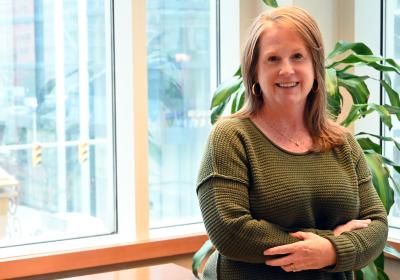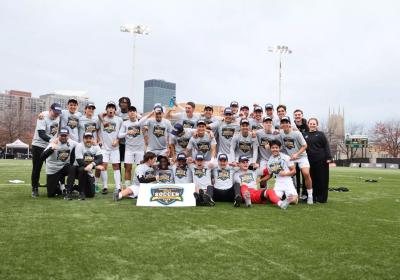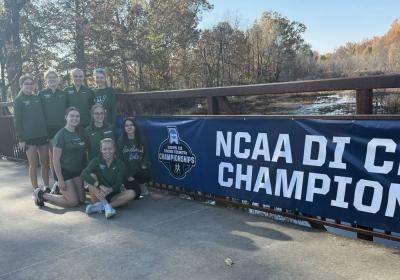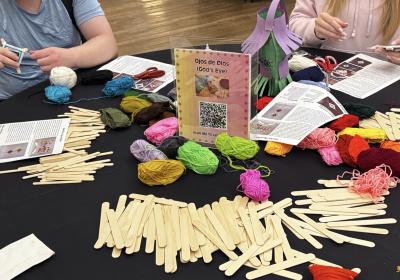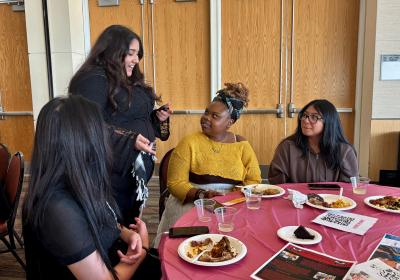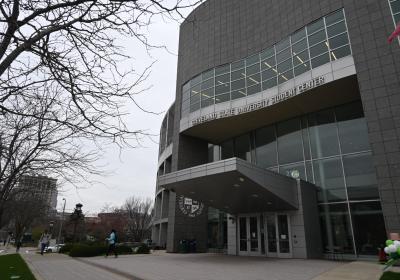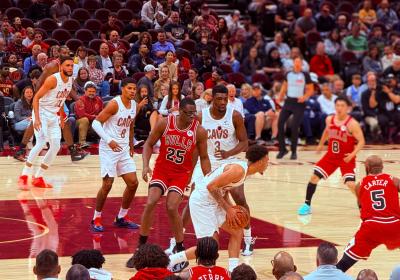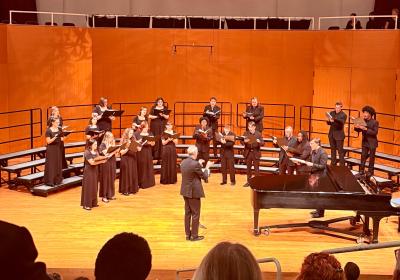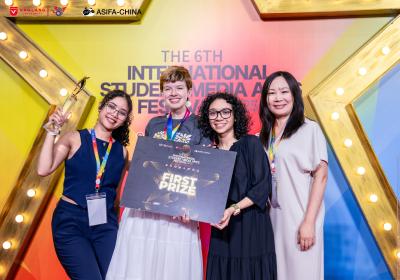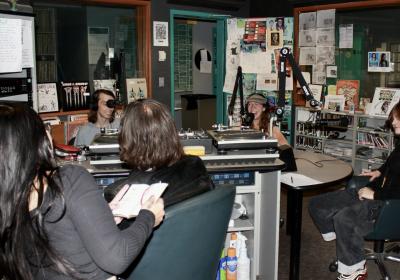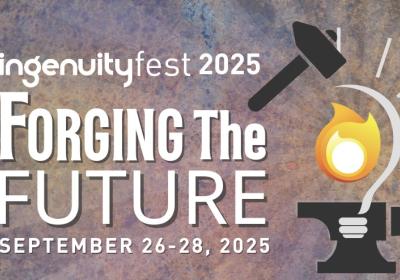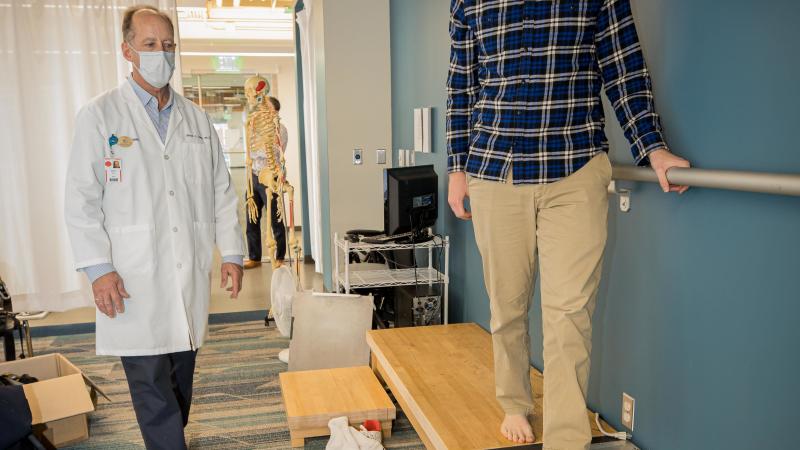
Professor acknowledged for his work on foot-related diabetic condition
Brian Davis, Ph.D., a professor in the Cleveland State engineering department, has received $75,000 in federal funding for his newest project, which focuses on developing a sensor-based system for monitoring stresses on a diabetic patient’s foot while they walk.
“I was very pleased to get this award,” Davis said. “It is the first federal grant I have received since joining CSU in 2019. I hope it is a forerunner of many more to come.”
One of the complications of diabetes is a condition known as Charcot Arthropathy. This is a complication that results in the collapse of a person’s foot. While it is not a common problem, it is devastating to those patients who experience a collapsed foot arch, and it often results in a foot being amputated. Davis's research is focused on preventing that from happening.
Davis’s approach is to develop sensors that can detect the initial occurrence of the condition, and allow time for treatment to occur before the foot arch totally collapses. There are very few labs in the world focusing on skin stresses on patients with diabetes. Most researchers concentrate their efforts at looking at pressure on skin, whereas Davis looks for both pressure and frictional forces.
Davis's funding was part of a larger grant awarded to Innovative Science Solutions Inc., based in Dayton. The college has had a productive working relationship with ISSI for more than 10 years.
Engineers and researchers at ISSI have collaborated with Davis’s CSU-based lab to develop a platform for measuring skin stresses. This project is a natural extension of those efforts, mainly to take the technology to a smaller scale and create in-shoe sensors.
“Looking ahead,” Davis said, “I anticipate bright students at CSU figuring out how to account for the influence of variables such as sweat, sock material, and weave patterns on frictional forces exerted on skin.”
Recent News
"Best Of" The Cleveland Stater fall 2025 #3
By JANE MATOUSEK - posted December 16, 2025This edition of the “Best of” the Stater features an interview with CSU President Laura Bloomberg, Ph.D., Thanksgiving festivities at CSU, underground student fashion in Cleveland, an Umoja event, and the hapless Cleveland Browns.
Viking View Beyond CSU fall 2025
By COM 324, COM 424 Students - posted December 18, 2025"Viking View Beyond CSU" is the end-of-semester project of the combined Com 324 and Com 424 classes in the School of Communication at Cleveland State University. Project teachers and mentors were John Ban and Dave Tarbert.
Why WCSB matters to me
By NICOLE WLOSZEK - posted October 16, 2025During my second semester at Cleveland State University, in February of 2025, I took the leap into college radio. It changed my life – then the station was taken over.
Dean Gordon expands mentoring, launches new programs as Levin College develops strategic plan
By ALEX MARTINEZ – posted December 3, 2025The Levin College of Public Affairs and Education is working towards the launch of a new leadership program for undergraduate students and continuation of the multi-media publication that tells the stories of Levin.
Men’s basketball falls to Missouri on the road
By GRACE SALTER | Cleveland State AthleticsCleveland State men's basketball (3-6, 0-0 Horizon League) fell to Missouri (8-0, 0-0 Southeastern Conference), 86-59, on Friday afternoon at the Mizzou Arena in Columbia, Missouri.
Community celebrates Thanksgiving with annual Vikesgiving event
By MORGAN ALTEN - posted November 26, 2025The smell of carved turkey and peach flambé filled Cleveland State University’s Viking Marketplace Thursday evening as hundreds of students, families and community members gathered for Vikesgiving, the university’s annual Thanksgiving-style celebration offering
Women’s basketball goes undefeated in CSU Invitational
By ANTHONY REED – posted December 1, 2025Cleveland State hosted its third annual multi-team event from Nov. 26- Nov. 29, with the women winning all three of their games as they improved to 7-1 on the season.
Men's soccer falls to Marshall 1-0 in NCAA tournament
By ANTHONY REED – posted November 26, 2025Cleveland State concluded its season on Nov. 20 with the loss to No. 12 Marshall in the first round of the 2025 NCAA tournament. Beaten but unbowed, the Vikings had a stellar season, capped with the Horizon League Tournament Championship.
Men's soccer claims 2025 HL Tournament Championship
By CLEVELAND STATE ATHLETICS - posted November 19, 2025Cleveland State (9-3-6) won the program's third Horizon League Tournament Championship in a 1-0 double overtime thriller over Purdue Fort Wayne (8-3-6, 5-2-2) on Saturday afternoon.
A "Survival Guide” to holiday questions from relatives
By AVA FUDURIC – posted NOVEMBER 12How to dodge, deflect and laugh off those personal family interrogations at the dinner table.
CSU launches anonymous reporting system through RealResponse
By RUBY DARWISH - posted November 20, 2025Cleveland State University officials announced Nov.
CSU cross-country wraps up 2025 season at NCAA Regionals
By AVA FUDURIC – posted November 17, 2025The Vikings finished 26th of 32 teams in the NCAA Regional on Nov. 14, achieving key goals as the 2025 season concluded.
CSU Rec Center launches free fall group fitness classes
By KATERYNA KOPYLCHAK – posted November 17, 2025The Cleveland State University Recreation Center has been offering fall group fitness, offering more than 20 free classes e
Africana Studies holds “Where Them Fans At/Boots on the Ground” fashion show
The Cleveland State Africana Studies Department invited the public to the Student Center Atrium on Nov. 6 for a fashion show celebrating black excellence and unity.
CSU women’s basketball secures first road win victory at Cal State Fullerton
By GRACE SALTER - posted November 14, 2025The Cleveland State women’s basketball team completed a West Coast comeback Sunday, earning a 68-61 victory at Cal State Fullerton. With the win, the Vikings improved to 2-0 on the season.
Game Stats
Cleveland State fencing earns 3 victories at OSU Elite Invitational
By KIRSTEN KIMBLER – posted November 11, 2025.The CSU fencing teams competed in The Ohio State University Elite Invitational on Nov. 8 and Nov. 9, with the women’s team earning all three combined event victories for CSU.
XCSB hosts Halloween Ball amid uncertainty following Ideastream takeover
By KIRSTEN KIMBLER – posted November 10, 2025“My day-of expectations were blown out of the water,” said Mario Benjamin, a senior popular music major at Cleveland State. “There were over 500 people in the venue. I was astonished at everyone who showed up and spent time at the ball.”
Cleveland celebrates Day of the Dead
Cleveland held its 22nd annual festival, Nov. 1, honoring those who have passed, featuring vibrant altars, a parade, and community celebrations at Gordon Square Arts District.
CSU faculty urged to help shape new state-mandated policies, admin defends WCSB takeover
By ALEX MARTINEZ – posted November 10, 2025At their 3rd senate meeting this semester, Cleveland State faculty were urged to comment on workload and tenure policies impacted by Senate Bill 1. Faculty also learned more about the Ideastream takeover of WCSB.
'Culture Craft Night' builds community through creativity
CSU's Campus Activity Board hosted the event which offered students the opportunity to learn about cultural crafts from around the world.
CSU’s Integrated Degree programs help students bridge disciplines
By AVA FUDURIC – posted November 5, 2025Cleveland State’s new integrated degrees give students the flexibility to pursue multiple passions – and prepare for an adaptable, interdisciplinary future.
"Best Of" The Cleveland Stater Fall 2025 #2
By JANE MATOUSEK - posted November 5, 2025Fall edition of "Best Of" The Cleveland Stater, 2025.
The Cleveland Browns continue to be the laughing stock of American sports
By ANTHONY REED – posted November 3, 2025The Cleveland Browns enter their bye week 2-6 as their offensive woes from last season continue to plague them.
CSU volleyball closes out homestand with loss to IUPUI
By ANTHONY REED – posted November 5, 2025The Vikings fell to 6-19 overall and 4-10 in league play after suffering a pair of losses at home to Indiana University Indianapolis on Oct. 31 and Nov. 1.
The New Era Scholars host Women’s Week: “Women United” event
By KIRSTEN KIMBLER – posted October 31, 2025“We wanted women to feel community with each other,” said Angellise Gray, vice president of the New Era Scholars. “With the women's center being shut down, women have lost their safe space to talk with one another.”
CSU women's swimming and diving defeat St. Bonaventure in home opener
By GRACE SALTER - posted October 31, 2025The Vikings concluded their two-day home opening dual on Oct. 25 with a 157–143 victory over St. Bonaventure, improving to 3-1 for the season.
CSU launches AI Teaching and Learning Lab for students
By AVA FUDURIC – posted October 28, 2025Set to open in spring 2026, the new lab in Berkman Hall will help students start to get a sense of what artificial intelligence is, experiment with it and engage ethically.
How to build a stronger resume: tips from CSU Career Services
By KATERYNA KOPYLCHAK - posted October 28, 2025Career Services helps students turn their resumes into strong, professional tools for success.
Cleveland State’s ELITE Program redefines ‘Earn and Learn’
By AVA FUDURIC – posted October 24, 2025Launched by the Washkewicz College of Engineering, the program helps students gain paid industry experience and provides a path to employment after graduation.
Cavs lose 3 of 4 preseason games in slow start
In their first preseason game of the season, the Cleveland Cavaliers on Oct. 7 collapsed late in the game, letting the Chicago Bulls steal the win. The preseason was a nightmare for the Cavs, who lost three of four games ahead of Wednesday's regular season opener in New York against the Knicks.
Big Brother season review: the best game of all time
By GRACE SALTER - posted October 21, 2025Recapping the drama, twists and standout moments of season 27 of Big Brother.
CSU Chorale and Chorus deliver dynamic fall performance
Cleveland State’s choirs on Oct. 9 filled Drinko Recital Hall with rich harmonies and a diverse repertoire spanning centuries of choral arrangements during their fall recital.
CSU students take 1st prize at media and arts festival in Vietnam
By KIRSTEN KIMBLER – posted October 20, 2025The Van Lang University auditorium buzzed with anticipation mid-summer as the animation awar
CSU men’s soccer shut out Detroit Mercy in a road victory
By ANTHONY REED – posted October 19, 2025The Vikings earned a 2-0 road win against Detroit Mercy on Saturday evening as their record improves to 5-2-5 overall, 3-0-3 in Horizon League play.
CSU men’s swimming and diving wins Akron Zips Classic
By ANTHONY REED – posted October 13, 2025Cleveland State took first place in the Zips Classic on Saturday night, with Youngstown State placing second and Xavier coming in third.
Theta Rho hosts bake sale to raise breast cancer awareness
By KATERYNA KOPYLCHAK – posted October 8, 2025October is Breast Cancer Awareness Month, and the Theta Rho chapter of Sigma Gamma Rho Sorority Inc.
‘Operation Love’ delivers food, supplies to Cleveland students and local residents
By RUBY DARWISH – posted October 9, 2025Cleveland State University student group New Era Scholars partnered with community organization New Era Cleveland last week to provide food, clothing and hygiene items to hundreds of people during a neighborhood event called "
CSU senate echoes low faculty morale, hears the latest on funding and SB1
By ANTHONY REED – posted October 8, 2025As Ohio’s Senate Bill 1 begins to take effect on campus, an increasing number of CSU faculty are speaking out about their concerns for its impact on their classrooms.
A campus divided? CSU student political leaders speak up
By AVA FUDURIC – posted October 6, 2025Student leaders of Cleveland State University’s two leading liberal and conservative political organizations discuss growing polarization on campus and why preserving open, respectful dialogue is key to keeping political tensions from boiling over.
Meet Dr. Peter Koritansky, head of CSU's Center for Civics, Society and Culture
By JANE MATOUSEK - posted October 6, 2025CSU hired Dr. Koritansky after the Ohio legislature in 2023 mandated that five of the state's 14 public universities set up centers to strengthen student understanding of U.S. history, politics and culture.
Students celebrate International Day of Sign
By KATERYNA KOPYLCHAK – posted October 6, 2025Cleveland State students marked the U.N. recognized International Day of Sign Languages to raise awareness of the challenges people with hearing conditions face and how community members can get involved.
Education Away Fair showcases off-campus academic programs
By KIRSTEN KIMBLER – posted October 6, 2025“Education Away is more than studying abroad,” said Ruthie Sasso, graduate assistant for Education Away. “We have all these opportunities that can kind of fit anyone's needs.”
WKYC welcomes students for behind-the-scenes newsroom tour
By GRACE SALTER - posted October 5, 2025WKYC News Director Julie Flynn stood before a group of Cleveland State University and John Carroll University students last week with one clear message: home is where the heart is.
CSU shuts down student-led WCSB, hands control to Ideastream
By JANE MATOUSEK - posted October 3, 2025Cleveland State University handed over control of the university’s student-led radio station to Ideastream on Friday, effectively shutting down 49-year-old WCSB 89.3. Perhaps unintentionally, CSU shuttered the station on College Radio Day.
IngenuityFest celebrates 20 years of cultivating community and creativity
By NICOLE WLOSZEK – posted September 25, 2025This weekend, IngenuityLabs will welcome the Greater Cleveland community to three days of adventure, innovation and imagination.
Cleveland Gaming Classic 2025 spotlights indie developers
This year's Cleveland Gaming Classic, a three-day convention, highlighted new guests, events, and indie developers at the I-X Center
Focus on CSU-TV, a new student organization
By KIRSTEN KIMBLER – posted September 26, 2025Brayden Geier, CSU-TV president, gives background on the soon-to-launch club and what students can expect.




